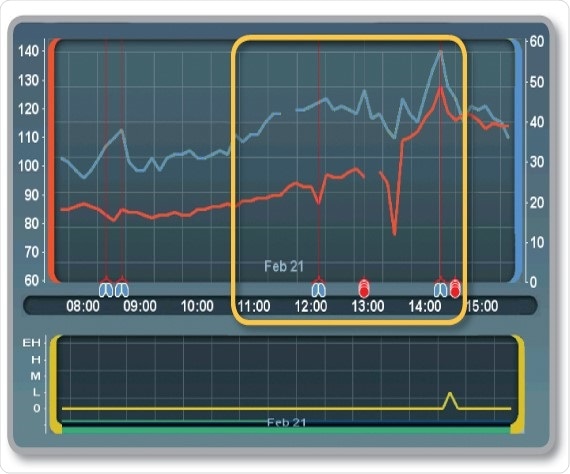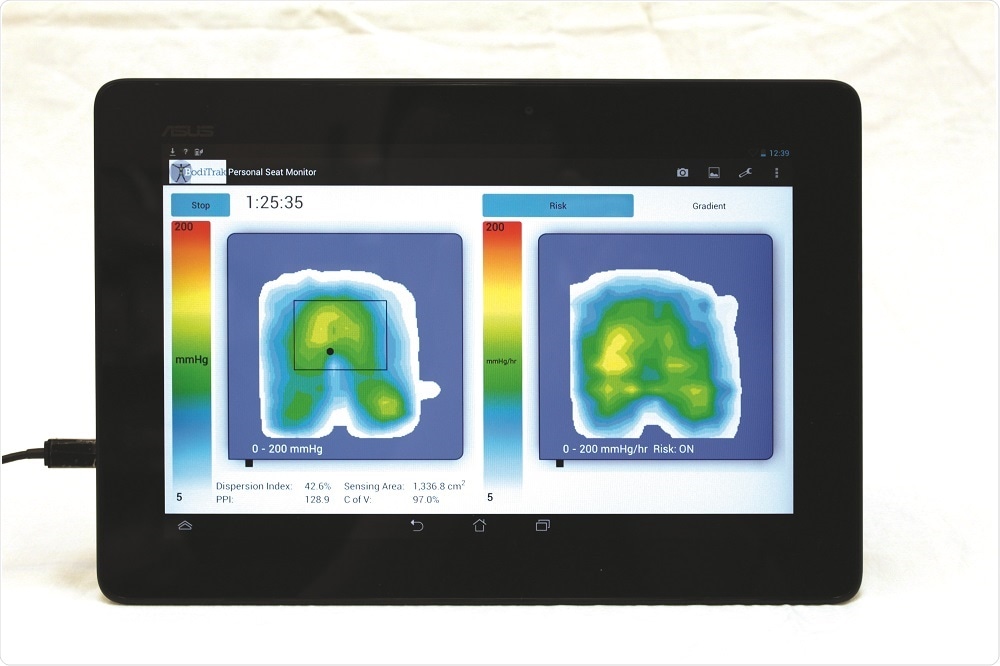An interview with Diane Hargrove and Sophie Lindvold at the NHS Health and Care Innovation Expo 2018 about how the technologies offered by BES Healthcare can be used to safely discharge patients from acute care and monitor their health status in the community.
What is the EarlySense Patient Monitoring System and how does it work?
Diane: The EarlySense Patient Monitoring System is a wireless, contact-free sensor that allows carers and clinicians to monitor the heart rate, respiration rate, and movement of patients over time.
The system comes in the form of a sensor, which can be placed underneath the patient’s mattress or transferred easily to be placed under seat cushion. Ensuring that patients able to sit out of bed, are still monitored without interruption.
As the system takes continuous measurements, the data builds and the trends in conjunction with sophisticated algorithms can be used to accurately detect significant signs of deterioration. These signs are linked to sepsis, hemorrhage, or other physiological changes.
The detection of movement levels is particularly useful for preventing falls and pressure ulcers. The system clearly shows the level of movement and has a turn time option enabling carers to reposition when necessary.
This can also help to prevent falls, as the increasing levels of movement detected can be used to predict when a person is likely to exit the bed around 30 minutes before the action occurs allowing intervention to prevent this happening and potentially averting a fall.
Sophie: What’s really great about the system is that it’s based on trend analysis. This means that the care you receive is based on you as an individual and is highly personalized.
Diane: An example of this is if you have a patient that is normally quite active in bed. The EarlySense Monitoring System allows you to “dial down” the sensitivity of the movement, so it isn’t going to alert the care team unnecessarily.
Reducing false alerts is vital. There is nothing worse than equipment that alerts all the time because this can lead to people just switching it off or ignore it. When EarlySense alerts you know you need to investigate as it’s based on continuous trends rather than a single point in time.
The data is stored wherever it is needed. In the NHS, for example, it can be sent straight through to the electronic patient record.
This is very useful from the point of view of traceability and the reporting of data. Alerts can be sent wirelessly to either a central nursing station, pagers or smartphone, allowing the care team to provide a response in real-time.
Quality of care has been directly related to length of stay in hospital, but many health care professionals are too busy to provide such a high level of care. How can this technology help caregivers?
Sophie: Patients using the EarlySense system are more relaxed as there are no alerts sounding all the time, or wires attached to them that might restrict their movement in bed.
This is also useful for the nurses who may be caring for the patient, as they have easier access to the patient and can do more value-added things like talking to a patient or helping with food.
We actually attended a conference a few weeks ago where we were speaking to a potential buyer, and his feedback was, “Wow, I'll actually get the time to care”.
This one of the fundamental things that nurses and clinicians no longer have time to do in their roles, and has a high impact on length of stay in hospital.
Diane: The system allows a more confident early discharge for patients and enables them to be monitored safely in the community.
This means they spend more time in their own home, rather than remaining in hospital or being moved to social services for care. It also reduces the likelihood that they will be re-admitted into acute care, as signs of deterioration can be detected early.
In the acute setting, the sensor is wired into a bedside display screen, which is very visible and useful for clinical staff to quickly check a patient’s vitals. However, in the community, we use a more discrete plug-in called the InSight system.
There's no display screen so it's not frightening for patients, it just sits there quietly, plugged in next to the bed, and again wirelessly streams the information through to pagers or a central team.
There is a very short window for detecting and treating Sepsis. How can the EarlySense Patient Monitoring System help clinicians identify cases of sepsis?
Sophie: I'm not a clinician, but whenever I've done research into sepsis, early detection can be life-saving. The system monitors your respiratory rate and heart rate two key systems that change when a person has sepsis.
It’s not going to be able to tell you “This is Sepsis” but because of the trend line you’ll be able to say “Okay, there have been some changes to the patients respiratory and heart rate that we need to investigate” and if they are already being treated for an infection you will be able to quickly suggest sepsis. You might also look for pneumonia, cardiac arrest, and so on.

Diane: Respiration rate, when taken on the ward, is often measured for only 15 seconds then multiplied up to a minute. This means the recorded data is often highly inaccurate and can lead to clinicians missing vital signs.
The EarlySense system gives a constant reading so clinicians can see significant changes to heart and respiratory rate over time and respond before the situation becomes critical.
We have gathered evidence which shows you can get up to eight to ten hours prior warning of that really critical phase. That 8-10 hour window could mean the difference between a really good outcome and a really poor outcome.
What is the BodiTrak pressure mapping system and how can it be used to prevent patients entering hospital?
Sophie: BodiTrak is a pressure mapping system that goes on top of the mattress or chair of the patient. The mat contains electronic sensors that measure the interface pressures between the patient and the surface, allowing caregivers to determine whether that pressure needs to be redistributed.
Diane: The system shows you the areas of the body which are under the most pressure and also allows you to determine which areas are most prone to be subject to shear forces.

This is very useful for patients who are immobile or have fragile skin for any reason and are in a fixed position for any length of time, particularly without sensation.
For example, this could be someone with a spinal cord injury, post-stroke, generally frail, or post-surgery who are unable to feel or move for any length of time.
These patients can’t move or adjust their position, making them highly vulnerable to tissue damage and pressure ulcers. Such injuries are very expensive for the NHS and can seriously affect a patient’s quality of life and long term outcome.
BodiTrak can also be used as an educational tool for patients, nurses or family caregivers in the community. Caregivers can use it to learn how to reposition patients and how to move them safely.
Sophie: Importantly, with BodiTrak you can take snapshots of the patient’s pressure map over time, and these can be stored as a PDF that can be shared over email between clinicians. This helps to assess when something started to go wrong with the patient, and whether positioning had anything to do with this.
Diane: Being able to produce a full record of interventions made and the care you have given is so important for accountability. You've got a record of what the patient was like before, what the intervention was, and what the outcome was.
One of the biggest challenges for the NHS is the lack of communication between patient and healthcare professionals once they have left hospital. How are the technologies developed by BES Healthcare working to address this?
Diane: We've talked to a lot of the NHS teams today, and one of their biggest priorities is to improve communication between patients and clinicians.
The sharing of data is imperative to this, even if there is no face-to-face contact between the patient and carer, having that technical dialogue could prevent so many patients re-entering acute care.
We also need to become better at integrating communication between everybody involved in a patient’s care, including clinicians, nurses, social care workers and family members.
There are some trusts that have started to use cloud-based systems between acute and community care settings, and this is proving to be very successful. We need to embrace technology and not be afraid of it, and I think this is something that we've really got a chance to make happen now.
Where can readers find more information?
About BES Healthcare
Based in Bristol, UK, BES Healthcare provides healthcare solutions to businesses, institutions, professionals, and services which are responsible for the provision of harm-free healthcare.
Over the past 25 years, BES Healthcare has achieved multiple successes introducing innovative and unique products to the UK, such as EarlySense and Boditrak.
It is BES Healthcare’s core ideology to promote education and solutions to provide better quality of care. This ideology along with innovative product range, have let BES Healthcare to become a respected player in its industry.